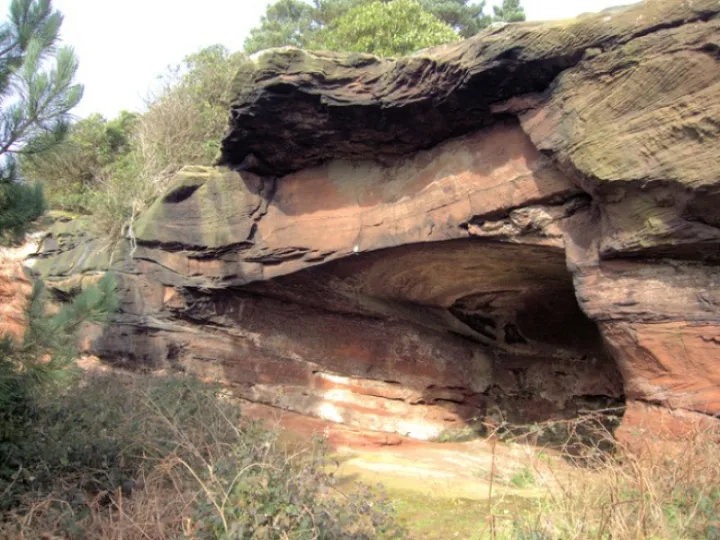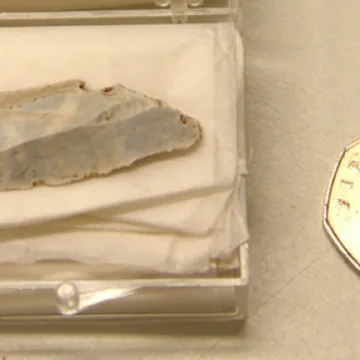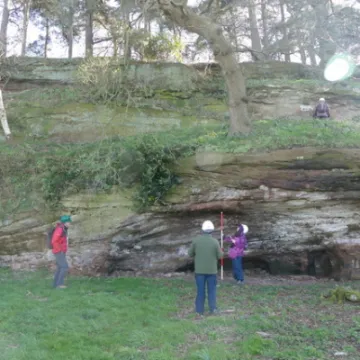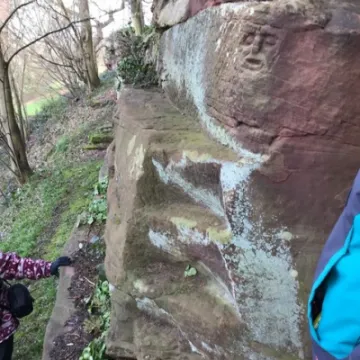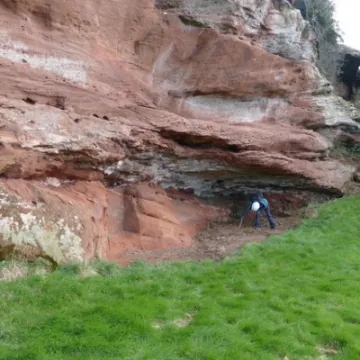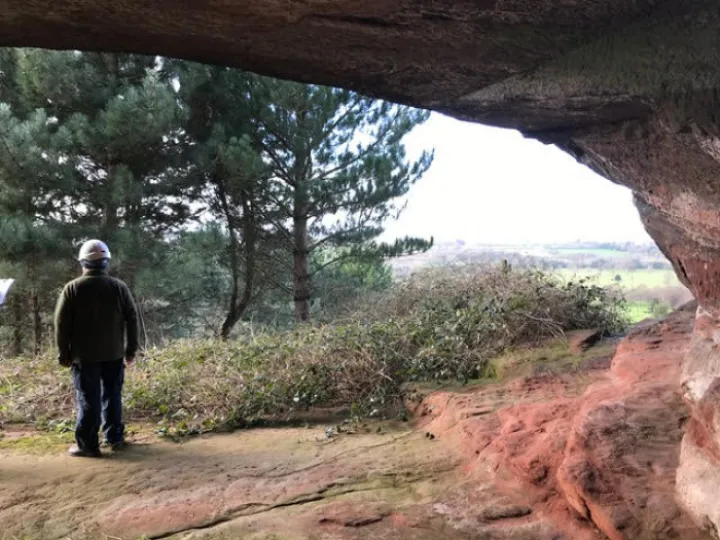'Beneath the Ridge' Volunteers visit Carden Park
On one of the last sunny days before the pandemic 'lockdown', with the kind permission of owners, Mr and Mrs Steve Morgan, and the assistance of their staff, a group of eight 'Beneath the Ridge' Volunteers visited Carden Park in order to examine the length of the low escarpment that runs along the west flank of the golf course. One cave, at the southernmost point of the escarpment is an archaeological site of some importance. It had been known as a hermitage occupied by an eighteenth-century recluse, John Harris, during the time that Carden was in the ownership of the Leche family (see photo 1).
Photo 1: John Harris' Hermitage
Field-work was conducted here by Chester Archaeology and Liverpool University in 1996-8.
Apart from discoveries relating to the hermit, large quantities of Late Mesolithic (6800-4300 BC) flints were found in the area in front of the cave (the 'talus'). The vast majority are chert 'debitage' – the waste flakes produced in the manufacture of tools. It has been suggested that this was not a permanent base-camp as no domestic debris was found, but more likely a hunting camp, as the tools that were found were mostly arrow-heads. The burnt shells of hazelnuts (a typical food) were carbon-dated to the Late Mesolithic. There was also evidence of Bronze Age habitation.
However, one flint tool from the Late Upper Palaeolithic era (11,000-9,000 BC) was also discovered (see photo 2). This suggests that there was some human occupation here in the era immediately after the last Ice Age. The finds are held at Liverpool University.
Photo 2: Palaeolithic flint tool found at Carden
The 'Beneath the Ridge' project has taken inspiration from these finds in its wider survey of the entire Ridge, and the visit to Carden had the objective of familiarising the volunteers with the morphology of the cave and its general aspect in the hope that it might provide a model when evaluating other similar sites along the Ridge.
Whilst the hermitage cave has received archaeological attention, other features along the escarpment have not been examined in the same detail and so it was part of the objective of the Trust's visit to record as many of these others as could be observed. In the northernmost section we saw a complex group of features that included an alcove, shelters, steps and niches, some of which are almost certainly C18th landscape features but there may have been a deeper cave here and the site would merit further examination (see photo 3).
Photo 3: Shelter at the northern end of the escarpment
The Cheshire Historic Environment Record describes the shelters as having 'very high prehistoric potential' and, in the light of the finds at the hermitage, this seems reasonable. Further along the escarpment are other features such as benches, tool marks, carved face and a stone wall suggestive of an C18th panoramic walkway. Carden Park was transformed by Leche's landscape gardener circa 1765-70 and the features probably date from that time (see photo 4).
Photo 4: C18th features
In their search for caves and shelters the Trust has been surprised to find how extensive was the landscaping of the Ridge in the past. Examples from Frodsham to Malpas suggest that there was a strong C18th Romantic feeling for the views westward and many panoramic walks with seats, niches, steps and other unusual features that have yet to be understood seem to have been constructed for the purpose of enjoying these views. The nearby cliffs at Broxton, Barnhill and Bolesworth all have similar features to those at Carden. See our recent article about the bear caves CLICK HERE.
At the southernmost part of the escarpment we were able to examine the hermitage itself. The hermit, John Harris, is thought to have been the same man who later lived in Mad Allen's Hole, high on Bickerton Hill. One of the most significant discoveries during the 1996-8 excavations was that Harris probably had a wooden house built across the mouth of the cave so his accommodation was much more comfortable than might be supposed. Another surprising addition to his comfort seems to have been a manservant! John Barlow from Barnhill, is said to have occupied the shelter next-door (see photo 5).
Photo 5: John Barlow's shelter?
Having now seen with our own eyes the site where the earliest inhabitants of Cheshire may have lived (see photo 6) we can begin to review the hundred similar sites that the project has identified along the length of our Ridge where, who knows, we may yet find more evidence of prehistoric life.
Photo 6: Where next?
Visit to Carden Park, 12 March, 2020 – Peter Winn – click on each image to enlarge

Sandstone Ridge Trust
Registered Company No. 7673603
Registered Charity No. 1144470
info@sandstoneridge.org.uk

